Common menu bar links
Breadcrumb Trail
ARCHIVED - Treasury Board of Canada Secretariat
 This page has been archived.
This page has been archived.
Archived Content
Information identified as archived on the Web is for reference, research or recordkeeping purposes. It has not been altered or updated after the date of archiving. Web pages that are archived on the Web are not subject to the Government of Canada Web Standards. As per the Communications Policy of the Government of Canada, you can request alternate formats on the "Contact Us" page.
President's Message
 I am pleased to present the Treasury Board of Canada Secretariat (the Secretariat) Departmental Performance Report for 2007–08. Each year,
the Secretariat issues this report to inform parliamentarians and Canadians about its progress in achieving the objectives outlined in its annual report on plans and priorities.
I am pleased to present the Treasury Board of Canada Secretariat (the Secretariat) Departmental Performance Report for 2007–08. Each year,
the Secretariat issues this report to inform parliamentarians and Canadians about its progress in achieving the objectives outlined in its annual report on plans and priorities.
The advice that the Secretariat provides to Treasury Board ministers and departments on programs, policies, and expenditures has real-life impact. From the testing of consumer products to the settlement of Aboriginal land claims to biofuels funding and incentives, the Secretariat is at the centre of responsible government spending decisions on behalf of Canadians.
A key element of this mandate is ensuring management excellence across the government, for which the Secretariat identified three key priorities for 2007–08: strengthening governance, accountability, and management practices; strengthening results-based expenditure management; and strengthening internal management. By promoting management excellence throughout government, the Secretariat strives to ensure a more efficient and effective public service that meets the evolving needs of Canadians while providing value for taxpayers' dollars.
This year, the Secretariat has made significant progress in each of the three priorities. For example, during this year the final provisions of the Federal Accountability Act, including the amendments to the Access to Information Act and the Privacy Act, were brought into force. This was followed, in July 2008, by the Lobbying Act, the last element. The Secretariat continued to move forward on the renewal of the Treasury Board policy suite, which will result in clearer and streamlined Treasury Board policies, ensure consistent approaches, and promote management excellence, while allowing for flexibility and innovation.
As part of the government's new Expenditure Management System, the Secretariat launched and completed the first round of strategic reviews in 17 federal organizations. This important initiative requires each organization to assess 100 per cent of all of its direct program spending and identify savings from its lowest performing, lowest priority programs. As outlined in Budget 2008, the savings identified are then available to be reinvested in areas of higher priority for Canadians. As a result of this thorough process, departments are transforming their operations, delivering better programs, and ensuring better results for Canadians.
In 2007–08, the Secretariat embarked on a Change Initiative that will help position the Secretariat to better deliver on the Government of Canada Management Agenda by strengthening internal management. This initiative will transform how the Secretariat interacts with its clients by focussing more on strategic leadership and embracing collaboration and risk management. This will enable the Secretariat to better help departments improve their own management performance and ensure better value-for-money for Canadians.
By promoting management excellence, the Secretariat is making government work better for Canada's citizens. In the year ahead, I look forward to continuing our efforts with the dedicated and committed men and women of the Secretariat.
The paper version was signed by
The Honourable Vic Toews, P.C., Q.C., M.P.
President of the Treasury Board
Section I: Departmental Overview
1.1 Raison d'Ļtre
The role of the Treasury Board of Canada Secretariat (the Secretariat) is to support the Treasury Board in ensuring that government is well managed and accountable and that its resources are allocated to achieve results. The Secretariat has a direct impact on governance, on accountability and the quality of federal public sector management, and on the efficiency and effectiveness with which the government's programs and services are delivered.
1.2 Responsibilities
Treasury Board
The Treasury Board is a Cabinet committee that was established in 1867 and given statutory powers in 1869. As the general manager of the public service, it has three key functions–to act as the government's management board, budget office, and employer of the core public administration.
The Secretariat supports the Treasury Board by providing advice to Treasury Board ministers on all of its responsibilities. The Secretariat's mandate includes management performance across government, expenditure and financial management, and management of compensation, pensions, benefits, terms and conditions of employment, and labour relations. Other organizations that support the Treasury Board are the Canada Public Service Agency and the Canada School of Public Service. These three organizations, together with the Office of the Registrar of Lobbyists, form the Treasury Board portfolio.
The Secretariat plays three key central agency roles in relation to other federal departments, agencies, and Crown corporations:
- an oversight role, including policy development, monitoring, and reporting on management and budgetary performance within government;
- an enabling role in helping departments and agencies improve their performance in these areas; and
- a leadership role in driving and modelling the management agenda.
Related to these roles, the Secretariat provides human resources management support to the Treasury Board in its role as employer of the core public administration by conducting labour-management relations and compensation operations and by managing pension and benefit policies and programs.
1.3 Operating environment
Like other large public and private sector organizations, the federal public service is also facing significant challenges as it adapts to key trends shaping Canadian society, the economy, the labour market, and service delivery. The rapid pace of technological change is fuelling fundamental changes in the way we live, the way we work, and the way organizations collaborate to deliver goods and services. Demographic changes are creating pressures to improve recruitment to the public service and enable mobility between the public and private sectors. This poses particular challenges for the Secretariat, in its role as employer, to find the balance between public sector interest in retaining a highly qualified workforce in a competitive environment and the flexibility required for skilled workers to leave and return to the public service.
The federal public service is a large and diverse national institution that:
- consists of over 175 departments, agencies, and organizations;
- includes about 460,000 employees; and
- maintains a presence around the world with federal offices in about 180 countries and 17 missions abroad involving the Canadian Forces.
In supporting the government, it is vital for the Secretariat to understand these trends and adapt policies and guidance to respond to these changes, while ensuring that government priorities and public expectations are met. Canadians expect spending to be aligned with federal government priorities. They demand an accountable government that manages their tax dollars by finding cost-effective ways to address public policy issues and provides services to Canadians. The challenge for the Secretariat is to find ways to ensure that the need for enhanced accountability does not prevent change or innovation across government. It is doing this in part by working to reduce the web of rules that has grown over the years and constrains intelligent risk-taking. An effective, high-performing public service is essential to meeting the expectations of Canadians. The Secretariat must work to ensure that the public service strives for excellence and remains connected to the needs and expectations of Canadians.
1.4 Strategic outcome and program activities
The work of the Secretariat is focussed on the following strategic outcome:
Government is well managed, accountable, and resources are allocated to achieve results.
The Government of Canada outcomes form part of the Whole-of-Government Framework, which maps the contributions of departments, agencies, and Crown corporations to a set of four high-level spending areas and thirteen government outcome areas. The alignment of departmental strategic outcomes to the governmental outcomes makes it possible to calculate and assess government spending by outcome area. The Secretariat's strategic outcome is aligned to the Government Affairs spending area and thus supports all of the government's outcome areas by helping departments, agencies, and Crown corporations meet their responsibilities, deliver their mandates, and serve Canadians.
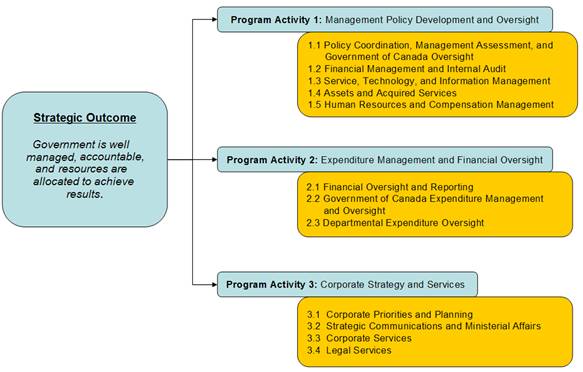
The chart above illustrates the Secretariat's framework of program activities and program sub-activities, which together contribute progress toward achieving the strategic outcome.
The Secretariat had established the three following priority areas for 2007–08:
- Strengthening governance, accountability, and management practices
- Improving accountability and fiscal responsibility through implementation of the Federal Accountability Act
- Strengthening results-based expenditure management
- Providing better advice, including clear expenditure information, to Cabinet and the Treasury Board on the allocation of resources
- Strengthening internal management
- Transforming the Secretariat to support the Government of Canada in moving forward with its management excellence agenda
Each priority corresponds to a specific program activity, as shown below:
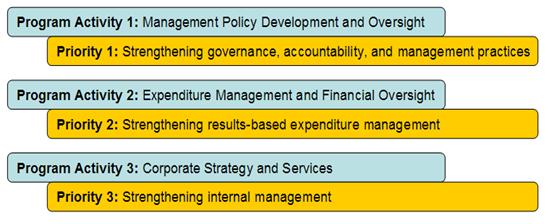
1.5 Achievements this year
In addition to the accomplishments profiled in section 1.6, the Secretariat had a number of significant achievements in 2007–08. For example, the Secretariat:
- Refined the Management Accountability Framework (MAF) and continued to promote it as the government's key management tool. The MAF assessment is now a key element for evaluating the management accountability of deputy ministers.
- Developed the Federal Accountability Action Plan to respond to the recommendations of the Independent Blue Ribbon Panel on Grants and Contributions and to reduce the administrative burden associated with related Treasury Board policies.
- Reviewed the government's financial oversight and control regime as input for renewal of the financial management framework and related policy instruments.
- Developed a renewed approach to the Expenditure Management System that fundamentally changes the way the government is managed. A key element of this was the first round of strategic reviews of 17 federal organizations, which identified $386 million per year that will be reallocated to higher priorities.
- Managed a full negotiation schedule with 26 of 27 active collective bargaining tables.
- Developed an integrated government-wide human resources plan for information management (IM) and information technology (IT) to assist federal departments and agencies in ensuring that they will have the required skills within the IM and IT area.
1.6 Summary of performance
Note: Some figures in this document may not add up to totals shown or some totals may differ from one table to another due to rounding off.
Departmental Priority: Strengthening governance, accountability, and management practices.
| Performance Indicators | Measures | Expected Results |
|---|---|---|
| Implementation of the Federal Accountability Act is successfully coordinated under the leadership of the Secretariat. | Commitments of all government departments under the Federal Accountability Act are well coordinated and targets are monitored. | Trust and confidence in government are enhanced through the implementation of the Federal Accountability Act and through improved reporting to Parliament. |
| Renewed policies are developed and implementation plans put in place in response to reviews of three key policy areas–grants and contributions, procurement, and financial management as mandated by the Federal Accountability Action Plan. | Approval of revised policies on grants and contributions is sought in response to the recommendations of the Independent Blue Ribbon Panel. | Responsibilities of deputy heads are clarified in accordance with the Federal Accountability Action Plan–streamlining rules while strengthening accountability and efficiency–through the renewal of the Treasury Board policy suite. |
Performance Summary: Progress in Achieving 2007–08 Priorities
Federal Accountability Act
In 2007–08, the Secretariat continued to build on last year's implementation progress by bringing into force a number of the provisions of the Federal Accountability Act, including the amendments to the Access to Information Act and the Privacy Act, and provided leadership in coordinating the government-wide implementation effort. Following public consultations, regulations needed to bring into force the Lobbying Act were drafted during the fiscal year; adoption of the Lobbying Act is anticipated for the first quarter of 2008–09, at which time the Federal Accountability Act would be brought completely into force.
Result: The Government of Canada has strengthened accountability and increased transparency in its operations, including access to information on an expanded range of government institutions. The Federal Accountability Act ensures that results for Canadians are achieved in a transparent manner with proper oversight.
The Treasury Board Policy on Transfer Payments
The Secretariat completed revisions to the Treasury Board Policy on Transfer Payments during 2007–08. The new policy reflects and, where appropriate, promotes key recommendations and principles of the Independent Blue Ribbon Panel. The Policy clarifies the responsibilities and accountabilities of ministers and deputy heads and establishes, in a manner that is sensitive to risk, the regime under which all grants and contributions will be managed. The administrative requirements for applicants and recipients of grants and contributions will be tailored to reflect the associated risks to ensure effective control, transparency, and accountability, while minimizing administrative burden.
Result: Simplified administration and strengthened accountability in the government's management of grants and contributions.
| Planned Spending ($ thousands)1 |
Total Authorities ($ thousands)1 |
Actual Spending ($ thousands)1 |
Alignment to Government of Canada Outcomes |
|---|---|---|---|
| 124,900 | 144,508 | 135,196 | Government Affairs |
1. Includes funds allocated from Corporate Strategy and Services. Supplementary information is available on the Secretariat's website at http://www.tbs-sct.gc.ca/dpr-rmr/st-ts-eng.asp.
Departmental Priority: Strengthening results-based expenditure management
| Performance Indicators | Measures | Expected Results |
|---|---|---|
| The first round of systematic reviews of program spending is conducted. | A process and a methodology are developed for strategic periodic reviews of program spending, which include the development of selection and sequencing criteria for reviews, the selection of candidates for review, and the launch of the first-year reviews. | Better information and advice are provided to Cabinet and the Treasury Board on new and existing programs to support decision making on resource allocation. |
| The quality of program performance information is improved through the Secretariat's leadership in the implementation of the Management, Resources, and Results Structure Policy (MRRS). | Client departments and agencies are supported in the development of their program activity architecture (PAA) and performance measurement framework (PMF). | Results-based management is strengthened and information on programs and spending is improved. |
Performance Summary: Progress in Achieving 2007–08 Priorities
Strategic reviews
The first round of strategic reviews was launched in June 2007. It included 17 organizations and $13.6 billion in spending–about 15 per cent of the government's direct program spending. The results of each strategic review were considered and were assessed against each organization's overall mandate and objectives, program effectiveness, efficiency, value-for-money, and alignment to government priorities. This enabled reallocation decisions to be made as part of budget planning.
Result: As a result of the strategic reviews, departments are streamlining operations, realigning their activities, and transforming their organizations to deliver better programs and better results for Canadians. From the departments that underwent the 2007 strategic reviews, $386 million per year was earmarked to be reallocated to help address the priorities of Canadians, as outlined in Budget 2008.
Management, Resources, and Results Structure Policy
In moving forward with the implementation of the MRRS Policy, departments have clarified their objectives, which are now captured in a PAA. In 2007–08, the focus was on identifying specific ways to measure progress toward achieving each of these objectives. Aligned with the PAA, these measurement tools were then assembled to create the departmental PMF, the second step of MRRS policy implementation. The Secretariat actively engaged departments throughout the year to support this work by offering targeted technical support, undertaking extensive reviews of departmental draft proposals, supporting senior management of various departments in promoting the benefits of the MRRS Policy, and offering sessions to raise awareness of PMFs and governance requirements of the MRRS Policy to over 800 public service employees.
Result: Improved performance information for decision making and reporting associated with resource allocation and reallocation and program management.
Supplementary information is available at http://www.tbs-sct.gc.ca/rma/mrrs-sgrr_e.asp
| Planned Spending ($ thousands)1 (Secretariat Operations) |
Total Authorities ($ thousands)1 (Secretariat Operations) |
Actual Spending ($ thousands)1 (Secretariat Operations) |
Alignment to Government of Canada Outcomes (Secretariat Operations) |
|---|---|---|---|
| 65,179 | 64,657 | 59,401 | Government Affairs |
1. Includes funds allocated from Corporate Strategy and Services. Supplementary information is available on the Secretariat's website at http://www.tbs-sct.gc.ca/dpr-rmr/st-ts-eng.asp
Departmental Priority: Strengthening internal management
| Performance Indicators | Measures | Expected Results |
|---|---|---|
| Internal and interdepartmental engagement strategies are developed and implemented to support the government's management agenda. | An action plan–focussed on key management initiatives and on new approaches to working with the Treasury Board, other departments, and central agencies–is developed and implemented within the Secretariat. | Corporate enabling strategies are developed and implemented within the Secretariat and across departments, consistent with the role of the Treasury Board. |
| Human resources management is improved, with progress on an open and transparent process for staffing, strengthened linkages to the Secretariat's business planning, and implementation of a human resources plan. | A human resources plan is completed in accordance with the Public Service Modernization Act. | Internal management practices continue to be improved in response to the Secretariat's Management Accountability Framework assessment and workplace surveys. |
Performance Summary: Progress in Achieving 2007–08 Priorities
Change AgendaIn 2007–08, the Secretariat undertook a Change Initiative to focus more on strategic leadership, collaboration, and risk management. This included development of a Secretariat roadmap for enabling change that supports the Government of Canada Management Agenda. Both internal and external awareness strategies were developed to engage executives and staff through
conferences and town hall meetings. The signing of the Management Excellence Charter, an agreement among all of the Secretariat's senior executives, demonstrates their commitment to the operationalization of the Change Initiative objectives through specific projects that embody its principles. The Secretariat received a strong rating, the highest ranking, in its Management
Accountability Framework assessment for its work in
2007–08 on change.
Result: Senior executives at the Secretariat are committed to transforming their business environment into one that embraces collaboration, risk management, and leadership to support departments, while leveraging the unique qualities, attributes, and capacities of the Secretariat and its workforce.
Human Resources Strategy
The Secretariat's efforts this year in improving the management of its workforce included the development and approval of the Human Resources (HR) Strategy in March 2008 and its work toward the objectives of the Public Service Renewal Action Plan. The HR Strategy outlines initiatives aimed at developing the capacity, diversity, competencies, skills, and leadership qualities of the current Secretariat workforce, as well as targeting the recruitment, training, and retention of future public service employees. The HR Strategy is a foundation document that will help the Secretariat better integrate expected HR requirements into its 2008–09 business planning cycle.
Result: The Secretariat is well positioned to continue developing its current workforce to better deliver on business objectives while working toward a clear vision of what its workplace and workforce of the future will be, as described in the Change Initiative.
| Planned Spending1&2 ($ thousands) |
Total Authorities1 ($ thousands) |
Actual Spending1 ($ thousands) |
Alignment to Government of Canada Outcomes |
|---|---|---|---|
| 54,095 | 58,135 | 58,752 | Government Affairs |
1. Allocated to the following program activities: Management Policy Development and Oversight and Expenditure Management and Financial Oversight.
2. Allocated to the program activities identified in note 1 and the Revitalization of the Toronto Waterfront activity.
1.7 Risk analysis
The Secretariat: A Trusted Advisor
The new Centre of Regulatory Expertise (CORE) is a model for enabling change across government. CORE started up in October to support the implementation of the new Cabinet Directive on Streamlining Regulation. Since then, CORE has provided training and expertise to 16 different departments and agencies on over 40 distinct regulatory initiatives. CORE's work supports departments in increasing the efficiency and effectiveness of the Secretariat's regulatory system.
As part of their work in 2007–08 on the next business planning cycle, Secretariat sectors were asked to identify risks that could potentially affect the achievement of their expected results and link them to the associated program activities. The exercise included rating the likelihood and impact of the identified risks, as well as the development of mitigation strategies.
The identification of risks within the business planning cycle and the development of a corporate risk profile (CRP) are the first steps toward managing risk within the Secretariat. To understand and reduce risks, the Secretariat will be building upon the progress made in 2007–08. This includes validating and updating its risk inventory on an ongoing basis, which will, in turn, support corporate understanding of the risks affecting the Secretariat's business activities.
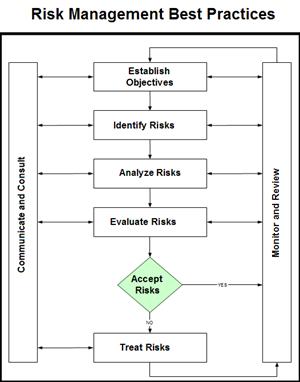 Lessons learned by the Secretariat in developing its first CRP include the following:
Lessons learned by the Secretariat in developing its first CRP include the following:
- Identifying corporate risks is challenging, so stakeholders from across the department must be involved;
- The probability and impact of risks fluctuate, so risks and their associated mitigation strategies need to be monitored regularly;
- There are various levels of risks, so there need to be mechanisms to manage the various types and levels of risks; and
- Resources need to be dedicated to manage risks, so risks cannot be managed without coordinated effort, including communications and training.
| Key Risks Identified in 2007–08 |
2007–08 RPP Subcommitments Associated with Key Risks Identified in 2007–08 |
Summary of Progress |
Associated Initiatives |
|---|---|---|---|
| Stakeholder: Departmental capacity to fully accept and implement the Secretariat management agenda. | Policies are supported by sound implementation plans as well as communications and training to support departments in meeting requirements. | Nearing Completion |
Change Management Action Plan
Policy suite renewal Improvements to the Management Accountability Framework |
| Directives, standards, and other guidance are developed and issued, and implementation of policy changes is commenced in the areas of grants and contributions and financial management. | In Progress | ||
| Forums are created to promote leadership of service transformation and facilitate the sharing of leading practices among deputy ministers, assistant deputy ministers, and management communities. | Completed | ||
| Management expectations are clarified and guidance is strengthened in the oversight of IM, IT, and service transformation projects. | Ongoing | ||
| People: Government employees need the right skills and competencies to deliver on the government's priorities. |
Implementation of a comprehensive multi-year HR Strategy for the financial management and internal audit communities is realized through the development of methodologies and tools that support enhanced professional capacity and community-based approaches. | Completed |
Secretariat HR Strategy
ES Development Program (targeted university recruitment campaign) Business planning exercise AS Competency-Based Management Framework and Learning Strategy Official Languages Policy and Secretariat Action Plan Talent Management Program for EX-02s and EX-03s |
| Services and products are developed to support the growth and development of leadership and HR capacity in key service transformation communities. | Completed | ||
| Core evaluation competencies are developed in collaboration with stakeholders and delivery agents. | Completed | ||
| Certification process is developed and a professional development program for government evaluators is launched. | Rescheduled for 2011 | ||
| People: The Secretariat needs the right people in order to deliver on its vision and mandate. |
An HR plan is completed in accordance with the Public Service Modernization Act. | Completed | |
| A corporate resourcing and recruitment plan that is aligned with the Secretariat's business requirements is developed, implemented, and integrated within the business planning process. | In Progress | ||
| The Secretariat's career development programs for key communities are strengthened and expanded. | In Progress | ||
| Compliance: Non-compliance consequences for departments must be appropriate and consistent. |
Compliance framework, which includes consequences for non-compliance, is developed for consideration by Treasury Board ministers. | In Progress |
Change Management Action Plan
Development of Compliance Framework Policy suite renewal |
| Mechanisms are established to monitor compliance and an appropriate range of measures is identified to address instances of poor management. | Completed | ||
| A broad approach to the management of compliance, including discipline, is supported by a committee of deputy ministers to ensure fair, equitable, and consistent practices. | In Place |
Supplementary information on the subcommitments identified is available on the Secretariat's website at
/dpr-rmr/st-ts-eng.asp.
1.8 Expenditure profile
| Expenditure | 2005–06 Actual |
2006–07 Actual |
2007–08 Actual |
|---|---|---|---|
| Management Policy Development and Oversight | |||
| Secretariat Operations | 103,557 | 119,465 | 135,196 |
| Expenditure Management and Financial Oversight | |||
| Secretariat Operations | 50,903 | 51,912 | 59,401 |
| Centrally Managed Funds | 1,423,799 | 1,537,987 | 1,662,001 |
| Revitalization of the Toronto Waterfront1 | 35,049 | – | |
| Total | 1,578,260 | 1,744,413 | 1,856,598 |
1. In accordance with the January 2007 changes in the minister's responsibilities, this authority was transferred from the Secretariat to Environment Canada through the 2007–08 Supplementary Estimates.
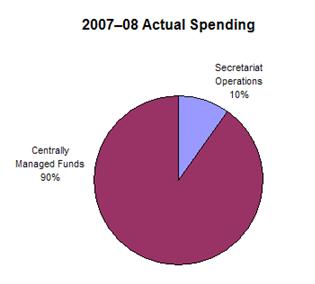 The Secretariat spent a total of $1.85 billion in providing its services in the 2007–08 fiscal year. It is important to note that only 10 per cent of this spending represents expenditures for the Secretariat's
operations. The remainder relates to funds managed centrally on behalf of the government as a whole.
The Secretariat spent a total of $1.85 billion in providing its services in the 2007–08 fiscal year. It is important to note that only 10 per cent of this spending represents expenditures for the Secretariat's
operations. The remainder relates to funds managed centrally on behalf of the government as a whole.
The largest part of actual expenditures (about 99 per cent) of the Centrally Managed Funds is Vote 20–Public Service Insurance. This vote covers the payment of the employer's share of health, income maintenance, and life insurance premiums; payments to or in respect of provincial health insurance plans; provincial payroll taxes; pension, benefit, and insurance plans for
employees engaged locally outside Canada; and payments to certain employees for their share of the employment insurance premium reduction.
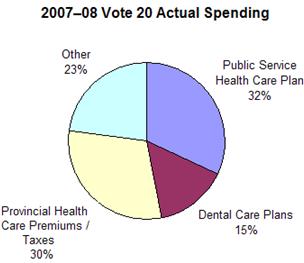 The major increase in expenditures over the last two years (2006–07; 2007–08) falls within Vote 20–Public Service Insurance. The increase is mainly due to increases in the number of members, costs,
and use of the health care and dental plans, as well as non-discretionary tax increases, which are mostly related to provincial payroll taxes.
The major increase in expenditures over the last two years (2006–07; 2007–08) falls within Vote 20–Public Service Insurance. The increase is mainly due to increases in the number of members, costs,
and use of the health care and dental plans, as well as non-discretionary tax increases, which are mostly related to provincial payroll taxes.
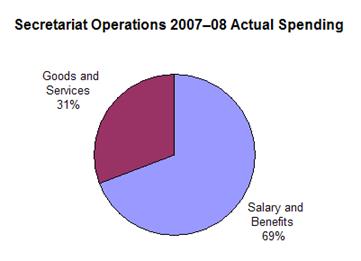 The Secretariat Operations reflects the people and organizations that support the Secretariat's central agency role of ensuring that government is well managed and accountable and that resources are
allocated to achieve results. The increase over the last two years in Secretariat Operations results mainly from funding received for the following:
The Secretariat Operations reflects the people and organizations that support the Secretariat's central agency role of ensuring that government is well managed and accountable and that resources are
allocated to achieve results. The increase over the last two years in Secretariat Operations results mainly from funding received for the following:
- The increased personnel costs of collective agreements between the Treasury Board and collective bargaining units representing public service employees;
- Support in implementing the Public Service Modernization Act;
- Implementation of the Cabinet Directive on Streamlining Regulations;
- Initiatives to implement the Federal Accountability Action Plan;
- The Budget Office Systems Renewal (BOSR) project; and
- A transfer of functions from the Privy Council Office in 2006–07 for Regulatory Affairs and Regional Communications.
| 2005Ł-06 | 2006-07 | 2007-08 |
|---|---|---|
| 1,048 | 1,179 | 1,332 |
